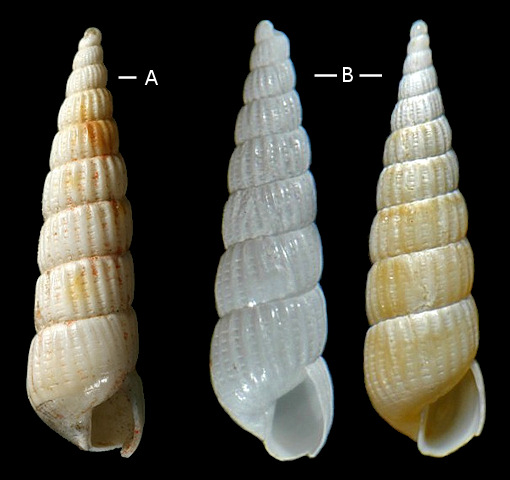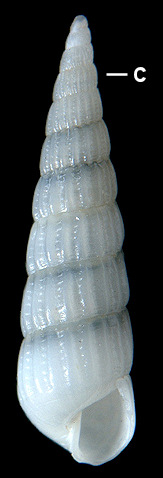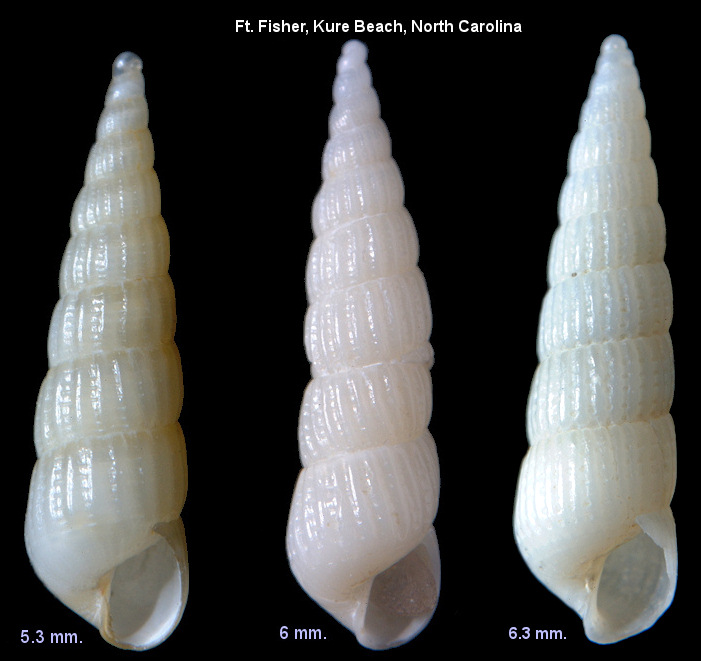|
There appears to be little doubt that Turbonilla caroliniana
Holmes, 1859 (p. 86; pl. XIII: figs 9, 9a, 9b) from Cainhoy, Wando
River, probably very late Post-Pleistocene (R. E. Petit, personal
communication, 12 Jan., 2006) is conspecific with Turbonilla
incisa Bush, 1899 (pp. 156-157; pl. VIII: fig. 12) described
from the Recent of west Florida. An image of the holotype of the
former (top, left: American Museum of Natural History [AMNH] originally
no. 5676; later 11369), produced and provided by Bushra Hussaini and
the fine work of Absalão and Pimenta (1999: 80, 86, 90: figs. 18, 19
[SEM]; see preceding page) elucidating a paratype (Academy of
Natural Sciences, Philadelphia [ANSP] 372503; holotype missing) of
the latter taxon help confirm the synonymy.
Turbonilla caroliniana is seldom mentioned in the literature. The few
citations encountered relate to its synonymy. Chemnitzia
reticulata C. B. Adams, 1850 (p. 75; Clench and Turner, 1950:
337) was considered a possible senior synonym of Turbonilla
caroliniana Holmes, 1859 by Dall (1892: 260; with a "?"). Later
Whitfield and Hovey (1901), Wolfe and Wolfe (1970), Odé & Speers
(1972), and Porter (1974) uncritically repeated Dall's observation omitting the question mark. Adams named C. reticulata
from Jamaica; it was never figured by its author, and its type
material was lost according to Clench and Turner (1950). It was
described as " ... white ... 26 to 30
[axial] transverse ribs, which become
obsolete on the anterior surface, with very coarse distant raised
spiral lines, decussating the ribs ... whorls about seven excluding
the nucleus, with a well-impressed suture : aperture oval, acute
above ...Mean divergence 12 degrees; length of spire 0.09 inch;
total length .125 inch; breadth .04 inch." The rib-count is much
higher, and the decussate sculpture, smaller size, absence of ribs on
the anterior surface of the body whorl are not consistent with T.
caroliniana. It is quite doubtful the two are synonymous.
Furthermore, given the vagueness of the description,
we
must consider Chemnitzia
reticulata C. B. Adams, 1850 a nomen
dubium pending location of type material, which isn't likely.
This research was stimulated by an inquiry made by Kevin Czaja to
the Conch-L Internet list-serve on Jan. 12, 2006. He remarked that
the name "Pyrgiscus caroliniana [sic] (Tuomey and [sic]
Holmes) Carolina Turbonille" appeared in a book dealing with the
shells of Martha's Vineyard (Heuer, 1970). Through a series of email
exchanges, including valuable comments from R. E. Petit (North Myrtle
Beach, SC), the proper attribution and generic assignment were
accomplished. Reference to Lester Stephens' (1988: 38-39) biography
of Holmes, which indicated the AMNH was sold some of the Holmes
collection, led to the catalogue record of the holotype (Whitfield
and Hovey, 1901: 474-475) and its being identified and photographed
by Susan Hewitt and Bushra
Hussaini at the AMNH. Now the identity of
Turbonilla caroliniana Holmes, 1859 appears established, and it
is a valid species, probably occurring throughout the Carolinian
Province. Its presence on Martha's Vineyard, however, requires
confirmation!
Absalão, R. S. and A. D. Pimenta, 1999. Turbonillla (Gastropoda:
Pyramidellidae) species described by Katharine Jeannette Bush:
scanning electron microscope studies of the type material in the
Academy of Natural Sciences of Philadelphia. Proc. Acad. Nat.
Sci. Philad. 149: 77-91. Jan. 29.
Adams, C. B., 1850. Contributions to Conchology 5: 69-75. Jan. [p.
75] [not seen, but see Clench and Turner, 1950]
Bush, K. J., 1899. Descriptions of new species of Turbonilla
of the western Atlantic fauna, with notes on those previously known.
Proc. Acad. Nat. Sci. Phila. 51: 145-177 + 1 pl. April.
https://biodiversitylibrary.org/page/6389312
Clench, W. J. and R. D. Turner, 1950a. The western Atlantic marine
mollusks described by C. B. Adams. Occ. Pap. Moll. 1(15):
233-403 incl. pls. 29-49. June 26.
Dall, W. H., 1892. Contributions to the Tertiary fauna of Florida
with especial reference to the silex-beds of Tampa and the Pliocene
beds of the Caloosahatchie River part II. Streptodont and other
gastropods, concluded. Transactions of the Wagner Free Institute of
Science 3 (2): 201-473 + map + pls. 8-21.
Heuer, R. J., Jr., 1970. Exploring for Sea Shells on Martha's
Vineyard. (Sponsored by the Felix Neck Wildlife Trust, Vineyard
Haven, MA) Privately printed, Northbrook, IL. 102 pp.
Holmes, F. S., 1858-1860 [published in parts]. Post-Pleiocene
Fossils of South Carolina. Russell and Jones, Charleston.1-98 +
14 pls. [R. E. Petit offers a collation of this rare and serial
work: Title page (dated 1860); verso: name of printer and engraver.
Dedication page; verso: Preface and acknowledgements. [i] - xii -
Introduction, [i]-v - Index; v verso: Errata, 1-64, pls. 1-10 -
Cover for Nos. 1 & 2 with printed date of 1858. "3, 4 + 5" plus "2
plates to a number" added in pen; 65-98, pls. 11-14 - Cover for
"Nos. 6 and 7" with printed date of 1859.]
Odé, H. and A. B. Speers, 1972. Notes concerning Texas beach shells.
Superfamily Pyramidellacea (continued). Texas Conchologist 8(8):
86-89.
Porter, H. J., 1974. The North Carolina marine and estuarine
Mollusca - an atlas of occurrence. Univ. N. C. Inst. Mar. Sci.,
Morehead City, vi + pp. 1-351. May.l
Stephens, L. D., 1988. The story of Francis Simmons Holmes.
Contributions from the Charleston Museum No. 17: xi + 67 pp.
Turgeon, D. D., J. F. Quinn, Jr., A. E. Bogan, E. V. Coan, F. G.
Hochberg, W. G. Lyons, P. M. Mikkelsen, R. J. Neves, C. F. E. Roper,
G. Rosenberg, B. Roth, A. Scheltema, F. G. Thompson, M. Vecchione,
and J. D. Williams, 1998. Common and scientific names of aquatic
invertebrates from the United States and Canada: mollusks, 2nd
edition. American Fisheries Society, Special Publication 26,
Bethesda, Maryland. ix + pp. 1-509 + 16 pls. (unpaginated).
Whitfield, R. P. and E. O. Hovey, 1901. Catalogue of the types and
figured specimens in the palaeontological collection .... American
Museum of Natural History .... Part IV, Lower Carboniferous to
Pleistocene, inclusive. Bull. Amer. Mus. Nat. Hist. 111(4):
357-500 + xv.
Wolfe, D. and N. Wolfe, 1970. Molluscs of North Carolina.
Carteret County Regional Marine Science Project, Beaufort, NC. 69
pp. [not seen].
PS: The description of "Turbonilla (viridaria var?) virga
n.s. ?" Dall (1884: 332), an available nominal taxon, sounds
suspiciously like this species also - but that's another problem for
another day. HGL |


